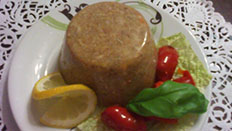Meats and Sausages
Zylc
Zylc is a traditional meat jelly from the northern part of Poland known as Pomerania. The area borders Baltic sea which is known for short waves, cold water and strong winds. Traditional Zylc was a meat jelly made from pork legs that agreed very well with vodka or beer. Native people living in the area known as Kaszuby started to incorporate pork heads and any meat cuts that remained after the pig’s slaughter.
Nowadays, it is difficult to buy a pork head, which is usually sold split into halves, clean and ready for cooking, so most people will substitute head with pork shoulder or upper part of front leg known as picnic. The meat requirement for a head cheese or meat jelly is basically the same as the manufacturing process remains almost the same. If stuffed into pork stomach or a large diameter synthetic casing the product becomes a head cheese, but if it is left to cool in a bowl it becomes a meat jelly. In both cases we need meat with a lot of connective tissue because such meat contains a lot of collagen that will first melt and then cool down forming a jelly. The jelly will connect all parts nicely together.
One could use a commercial gelatin which will bind any type of meat, with connective tissue or not, however the taste and flavor of the finished product will be different. A meat jelly made with mixed with water gelatin powder has a neutral flavor, but the liquid that remains after cooking meats and vegetables is a wonderfully tasting meat stock, so the traditionally made meat jelly exhibits a superior taste and flavor.
Kaszuby introduced some notable differences, firstly, they grind all cooked materials through a fine plate, secondly, they add enough vinegar so the product develops a slightly sourly flavor. Most people eat head cheese or meat jelly with lemon juice, vinegar or pickled cucumber anyhow, so adding vinegar works very well. An American headcheese known as Souse also contains a noticeable amount of vinegar.
| Meats | Metric | US |
|---|---|---|
| Pork heads (with bones) | 700 g | 1.54 lb |
| Pork leg (picnic) | 200 g | 0.44 lb |
| Pork hocks (feet) | 200 g | 0.44 lb |
| Pork skins | 100 g | 0.22 lb |
Ingredients per 1000g (1 kg) of meat
| Pepper, whole | 2.0 g | 2 tsp |
| Onion | 70 g | 1 small |
| Carrot | 60 g | 2 |
| Parsley root | 30 g | 1 stalk |
| Celery | 50 g | 1 |
| Bay leaf, whole | 0.30 g | 2 |
| Allspice, berry | 0.50 g | 2 |
| Marjoram, ground | 1.0 g | ½ tsp |
| Sugar | 5.0 g | 1 tsp |
| Vinegar | 60 ml | 2 oz fl |
Instructions
- Place all meats with pepper, allspice and bay leaves in a pot and add enough water to over them. Cook on low heat 2 hours. Add vegetables and cook for about 60 minutes more until meats are easily separated from bones.
- Drain the stock and save.
- Separate meats from bones, cool, then grind with vegetables through ¼” (6 mm) plate.
- Recombine ground meats and vegetables with stock, add spices and ½ vinegar and bring to boil. Taste and add more vinegar if needed.
- Meat jelly: using ladle fill the bowls or jars with the mixture, let cool and then place in refrigerator. It is up to you how much jelly you want in a finished product. Before filling bowl, you may place on the bottom a slice of hard-boiled egg, carrot, lemon, green peas or fresh parsley as a decoration. When a solidified jelly is removed from the bowl and flipped over the decorations will be on top.
- Head cheese: using ladle pour the mixture into 60-100 mm casings and cook in water at 80° C for 60 minutes. Add less stock than for jelly. Immerse in cold water for 15 minutes, then place on the table to cool. Keep in refrigerator overnight. Ready to eat when solidified.


















